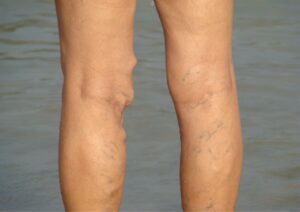Spider veins, also known as telangiectasias, are small, dilated blood vessels that appear close to the surface of the skin. They often resemble a web or a branching tree, which is why they are commonly referred to as “spider veins” or “ankle spider veins” when they appear around the ankle area. While spider veins can occur anywhere on the body, they are particularly common on the legs and feet. These visible veins can be a cosmetic concern for many people, but they may also cause discomfort or indicate an underlying vascular issue. In this blog, we’ll explore what causes spider veins on the feet, how they can be treated, and what steps you can take to prevent them.
What Causes Spider Veins on the Feet?
Spider veins develop when the small valves within the veins become weakened or damaged, leading to poor circulation. Chronic venous insufficiency, a condition where the valves in the veins malfunction, can also contribute to the development of spider veins. Blood that should be moving toward the heart can begin to pool in the veins, causing them to swell and become more visible. Several factors can contribute to the development of spider veins on the feet:
1. Genetics
One of the most significant factors in the development of spider veins is genetics. If your parents or close relatives have spider veins, you are more likely to develop them as well. The inherited tendency towards weaker vein walls or valves can make you more susceptible to this condition.
2. Prolonged Standing or Sitting Affecting Blood Flow
Occupations that require long periods of standing or sitting can contribute to the formation of spider veins. When you stand or sit for extended periods, blood can pool in the lower extremities, increasing pressure in the veins and leading to spider veins, particularly on the feet and ankle veins.
3. Hormonal Changes
Hormonal fluctuations, particularly in women, can play a significant role in the development of spider veins. Pregnancy, menstruation, and menopause are times when hormone levels change, affecting the elasticity and function of the veins, thereby increasing the risk of developing spider veins. During pregnancy, the increased blood volume and pressure from the growing uterus can also contribute to the formation of spider veins.
4. Aging
As we age, our veins lose elasticity, and the valves within them may not function as efficiently. This natural aging process can lead to the development of spider veins, especially in the feet where blood circulation can be more challenging.
5. Obesity
Excess weight puts additional pressure on the veins in the legs and feet, making it harder for blood to flow back to the heart. This increased pressure can lead to the formation of spider veins and other venous issues, including developing varicose veins.
6. Injury or Trauma
Previous injuries or trauma to the feet or legs can damage the veins, leading to the development of spider veins. This can include anything from a direct impact to the foot to surgical procedures that affect the blood vessels.
Symptoms of Spider Veins on Feet
While spider veins are often harmless and primarily a cosmetic concern, they can sometimes cause symptoms, including:
Aching or Throbbing Pain: Some people experience discomfort in the area where spider veins are present, particularly after standing for long periods.
Swelling: The feet may become swollen, especially after a day of standing or walking.
Itching or Burning Sensation: The skin over the spider veins may feel itchy or have a burning sensation.
Heaviness in the Legs: Some individuals report a feeling of heaviness or fatigue in their legs and feet, especially at the end of the day.
It is important to note that spider veins rarely cause serious symptoms, but any changes in appearance or sensation should be evaluated by a healthcare professional.
Treatment Options for Spider Veins on Feet
Several treatment options are available for those who wish to reduce the appearance of spider veins on their feet or alleviate any associated discomfort. In addition to spider veins, reticular veins, which are also visible but larger, can be treated using similar methods.
1. Sclerotherapy
Sclerotherapy is one of the most common and effective treatments for varicose veins and spider veins. During this procedure, a solution is injected directly into the affected veins, causing them to collapse and gradually fade away. Sclerotherapy is minimally invasive, requires no downtime, and is typically performed in a doctor’s office.
2. Laser Therapy
Laser therapy uses focused light energy to target and destroy the affected veins. The heat from the laser causes the vein to clot and eventually be reabsorbed by the body, making it particularly useful for treating foot veins. This treatment is particularly useful for smaller spider veins and is non-invasive, though it may require multiple sessions for optimal results.
3. Using Compression Stockings
Wearing compression stockings can help improve blood flow in the legs and reduce the formation of spider veins. These stockings apply gentle pressure to the legs, encouraging blood to flow back towards the heart and preventing it from pooling in the veins. While compression stockings do not remove existing spider veins, they can help alleviate symptoms and prevent further progression, and are also commonly used to treat varicose veins.
4. Lifestyle Changes
Making certain lifestyle changes can also help manage and prevent spider veins. Maintaining a healthy weight, staying active, and avoiding prolonged periods of standing or sitting can all contribute to better vascular health.
Prevention Tips for Spider Veins on Feet
While not all spider veins can be prevented, there are several steps you can take to reduce your risk of developing them on your feet:
– Exercise Regularly: Regular physical activity helps improve circulation and reduces the pressure on your veins.
– Elevate Your Legs: When resting, elevate your legs above heart level to promote better blood flow and prevent pooling.
– Avoid Tight Clothing: Tight clothing, especially around the waist, legs, and groin, can restrict blood flow and increase the risk of spider veins.
– Stay Hydrated: Drinking plenty of water helps maintain healthy circulation and prevent blood from thickening, which can contribute to vein problems.
– Protect Your Skin: Use sunscreen to protect your skin from UV damage, which can weaken blood vessels and contribute to the formation of spider veins.
When to See a Doctor
If your spider veins are causing significant discomfort, or if you notice other symptoms such as swelling, pain, or changes in skin color, it’s important to consult with a healthcare professional. They can evaluate your condition, recommend appropriate treatments, and rule out any underlying venous disorders, such as blood clots, that may require attention.
Conclusion
Spider veins on the feet are a common issue that can be both a cosmetic and physical concern. While they are often harmless, understanding the causes and available treatment options can help you manage or even prevent them. By making lifestyle changes and seeking appropriate medical care when necessary, you can keep your feet looking and feeling their best.









